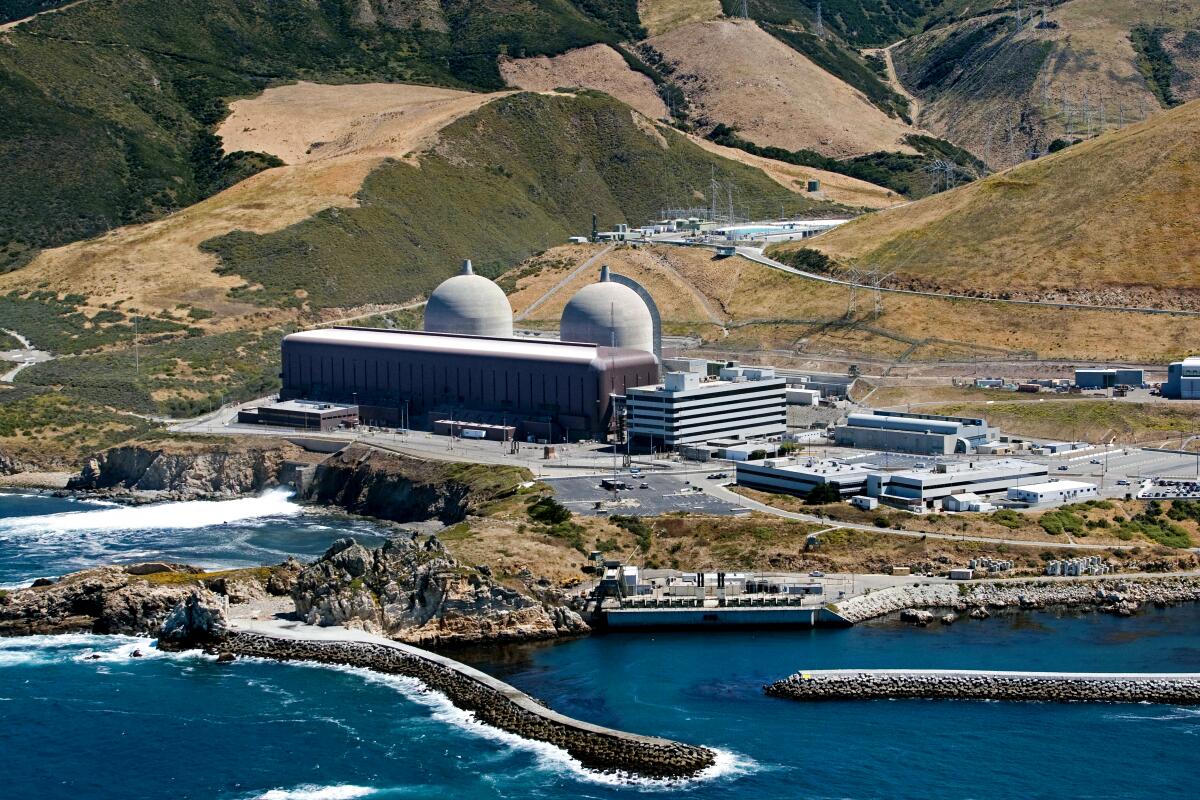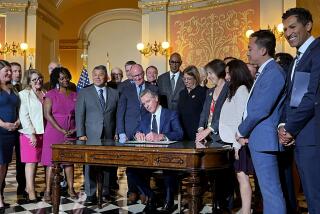Lawmakers approve $1.4-billion loan for PG&E to keep Diablo Canyon nuclear plant open

SACRAMENTO — California lawmakers voted to keep the Diablo Canyon nuclear plant open for five more years, ultimately siding with Gov. Gavin Newsom’s controversial call to lend Pacific Gas & Electric up to $1.4 billion and reverse plans to shutter the facility.
PG&E agreed six years ago to close the plant in 2025 in part because of safety concerns in the event of a major earthquake along fault lines near the coastal San Luis Obispo County site and as environmental groups pressured the state to do more to meet its renewable energy goals.
But California’s inability to avoid rolling blackouts during 2020 heat waves prompted Newsom to reconsider closing Diablo, the state’s single largest power source. The plant generated 6% of California’s electricity last year.
“This bill is necessary,” said Sen. Bill Dodd (D-Napa), who carried the legislation. “Blackouts are a real threat and pose economic, health and safety risks, especially for the most vulnerable Californians.”
The governor’s office began lobbying the Legislature in August to pass legislation keeping the plant open, arguing that shutting down the facility could lead to more rolling blackouts like those that endangered vulnerable residents two years ago and caused a political headache for Newsom.
Democratic and Republican lawmakers voted in support of the bill hours after Newsom and state officials warned about an impending heat wave through Labor Day that threatens to challenge the reliability of the state’s electrical grid once again.
Environmental groups have said that continuing operations at the plant runs contrary to the state’s clean energy goals. After Newsom asked Californians to turn their thermostats up this week, he defended his “de-risking strategy.” He said the plant doesn’t generate harmful emissions, adopting a message the nuclear industry has used for years, and provides a dependable source of power.
“This is critical in the context of making sure we have energy reliability going forward,” Newsom said. “That energy does not produce greenhouse gases. That energy provides baseload and reliability and affordability that will complement and allow us to stack all of the green energy that we’re bringing online at record rates.”
The governor added pressure to lawmakers, who he predicted would help California “de-risk and get over the finish line the remaining components of our energy plan and our climate package.”
Newsom introduced draft legislation to continue Diablo operations two weeks ago, setting off a fierce debate between environmental groups and stoking frustration among lawmakers about the last-minute push on such a controversial proposal. Lawmakers made changes to Newsom’s original proposal, including shortening the extension of the plant’s operations from a decade down to five years, and introduced SB 846 late Sunday evening.
“There will be no barrier as great to achievement of our clean energy goals as an unreliable electric grid,” said Assemblymember Chris Holden (D-Pasadena). “I’m not a proponent of the Diablo Canyon power plant but I am a proponent of keeping the lights on.”
Some Republicans who supported the legislation said they had previously warned that California’s clean energy goals would affect reliability of the electrical grid. Lawmakers in both parties reminded their colleagues that former Gov. Gray Davis was recalled in part due to an energy crisis that forced rolling blackouts two decades ago.
“You can’t have it both ways,” said Assemblymember Jim Patterson (R-Fresno). “You can’t say to the people of California, we’ll keep your lights on and we’ll do it affordably at the same time that we make those very affordable electrons unavailable.”
Friends of the Earth, which helped land a deal six years ago to close Diablo Canyon, called the governor’s decision to try to extend its life “reckless beyond belief.” The nonprofit environmental advocacy organization ran digital ads this week urging closure of Diablo and warning that “one earthquake could expose millions to radiation.”
Erich Pica, president of Friends of the Earth, said his organization agreed to drop a lawsuit against PG&E over the earthquake safety concerns as part of the negotiated agreement to close the site in 2016.
After nearly a year and a half of debate, the California Public Utilities Commission followed in 2018 and officially approved a plan to close the first reactor unit in 2024 and the second the following year.
Pica criticized the governor’s effort to disregard the “responsible timeline” the state, PG&E and environmental groups had agreed upon in 2016 without a single study from any state agency supporting Newsom’s fear that the state will not have enough electricity if Diablo closes.
“Other than the governor, there hasn’t been anybody really pushing this up to this point,” Pica said. “Governors have been recalled in the past over energy. I think there’s just a fear from his perspective that this could avalanche into a political crisis for him.”
Among the more controversial aspects of the governor’s legislation is a provision to offer PG&E a $1.4-billion forgivable loan “to facilitate the extension of the operating period of the Diablo Canyon power plant.” Pica and others have criticized the rushed nature of the proposal and the lack of clarity about the financial effects on PG&E ratepayers or the state.
“It’s just a really poorly timed, poorly conceived proposal that’s rushed to a conclusion without understanding, other than the governor’s own fear, what’s really happening in the state,” he said.
To succeed in extending operations, PG&E must seek federal approval.
The governor balanced his call to continue the power plant’s operations with a request for lawmakers to pass several climate bills. Introduced over the last two weeks, the legislation enacts more aggressive targets on state laws that reduce greenhouse gases and increase the use of renewable energy.
Lawmakers approved SB 1137 on Wednesday to establish health and safety buffer zones around new oil and gas wells, a key bill in Newsom’s climate package. Similar restrictions had failed to move forward in prior years, succumbing to intense lobbying opposition from the oil industry and trade unions.
More to Read
Sign up for Essential California
The most important California stories and recommendations in your inbox every morning.
You may occasionally receive promotional content from the Los Angeles Times.











